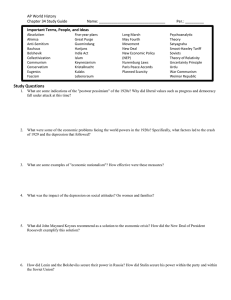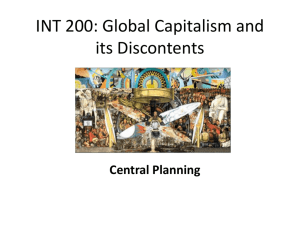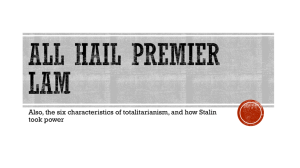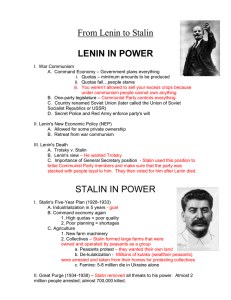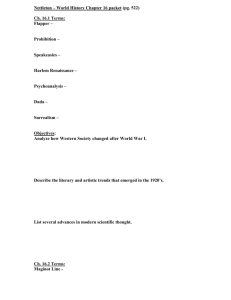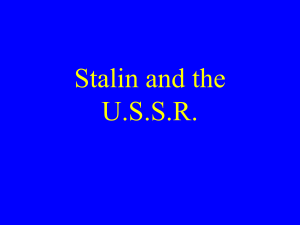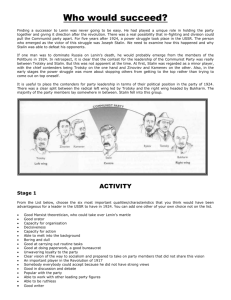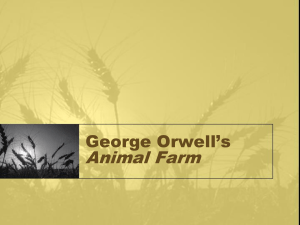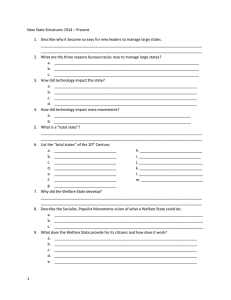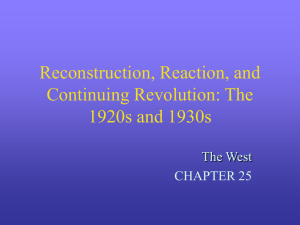Between the Wars 1919-1939
advertisement
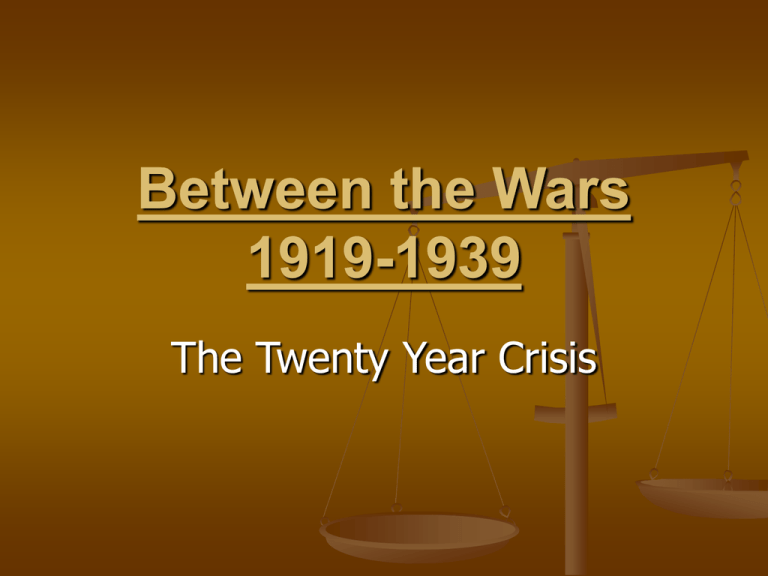
Between the Wars 1919-1939 The Twenty Year Crisis The Post War Era – 1920’s Rise of leisure activities & purchase of consumer goods Shorter workdays and slowly improving economies = more money/time for fun Lindbergh’s first solo flight across Atlantic sign of new era of progress Prohibition (1920-1933)- difficult to enforce as many enjoyed time in Jazz clubs First movie with sound Police raid during Prohibition I. Postwar Prosperity Crumbles Signs of Economic Troubles Farmers – struggled while industry prospered (demand fell-prices fell-farmers not making money and can’t pay debt) Protectionism – economic nationalism – limit trade with other nations to protect domestic industry Tariffs – Tax on imports, raises prices to protect country from foreign competition Stock Market Black Tuesday – stock market crashed (prices fell = stocks worth much less than people bought them for) Speculation– risky investments in stock market (people hoping to get rich quick). Wall Street 10/29/29 The Great Depression Worldwide (global) depression (1929-1940) prices and wages fell business activity slowed unemployment rose Goods available but no money to buy them Tried Economic Nationalism – limited trading actually hurt countries Can you read the banner? Herbert Hoover President of the U.S. when the Depression began He did very little to improve the effects of the Depression (believed gov’t should act as a facilitator and not offer direct relief) Lost election to FDR in 1932 Franklin D. Roosevelt Elected President in 1932, 1936, 1940, 1944 The New Deal Programs of relief and reform Gave money to states for food, clothing, shelter and created job through work programs (build roads, bridges, etc) Social Security Act provided for unemployment and old-age benefits Programs Under New Deal II. Political Tensions After WWI France’s Postwar Difficulties The Economy – government and individuals in debt (land in ruins, inflation, cost of Maginot line) International Affairs – Locarno Pact pledged that countries would peacefully settle all future disputes Political Unrest – strikes in various industries; Popular Front came to power, then fell; extremist actions Great Britain After WWI Labor Troubles – outdated industry, unemployment (25%), unions wanted increase in wages Ireland – bloody revolt against Great Britain; Irish Republican Army fought for independence Eastern Europe Weak economies Conflicts between socialists and conservatives (government controlled economy or command economy vs. free market) New boundaries caused unrest III. Fascist Dictatorships The Rise of Fascism in Italy Fascism – dictatorship and totalitarianism, opposed communism and democracy (rigid control through force/censorship) Mussolini’s rise to power – appointed Fascists to all official positions in center government The corporatist state – major economic activities were organized similar to corporations The Nazis and Hitler Treaty of Versailles- viewed as humiliating and unfair Nazi Party – extremely nationalistic, anti-Semitic Hitler – planned racial purity, repeal the Treaty of Versailles, created anticommunist hysteria Fascism Communism Class Preserve existing social class Property Encourage Share all ownership of property private property communally Government Power Abolish social classes Control through Control through force and force and censorship censorship IV. Dictatorship in the Soviet Union Review: Russian Revolution Why was there a revolution in Russia? Who came to power afterward? After Lenin died there was a struggle for power between Trotsky and Stalin. Stalin prevails. Write the answer in your notes If you had a choice, would you rather live under a communist controlled country or one led by a fascist dictator. Explain using a specific example to support your choice. Russia Under Lenin New Economic Policy – nationalized industries (government owns them now), collective farms (peasants were asked to join farms together for better production) 1929 – 4% by 1931 – more than 50% Women’s Roles – gave women more rights, seen as equal to men Education was a priority The Five-Year Plan Ambitious agricultural, industrial, and social goals to create a modern, industrialized society Caused hardships for Soviet people, were forced to comply Stalin’s Dictatorship Government Under Stalin – purge of disloyal party members, extended to general population Foreign Policy – wanted rest of world to accept Soviet Union and tried to spread Communism (Comintern) Problem Solution Results Moderately successful Near Econ. Collapse in 1921 Lenin's new policy allowed for some free enterprise Agriculture Collective farms Failed: famine Power struggle btwn Trotsky and Stalin Savage and brutal competition Stalin emerged as leader Little Economic Growth Stalin’s first 5year plan No increase in consumer goods Second 5-year plan Succeeded in reviving industry somewhat Industry grew, people starved resulted, 7 million die (1932-33) How did Stalin rise to power? Gained control of communist party after Lenin’s death Why did the Soviet system of government make the development of a police state possible? Before communism the Czars used secret police and spies to maintain control of the people
